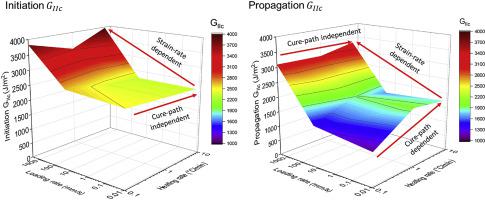当前位置:
X-MOL 学术
›
Compos. Sci. Technol.
›
论文详情
Our official English website, www.x-mol.net, welcomes your
feedback! (Note: you will need to create a separate account there.)
Cure path dependency of static and dynamic Mode II interlaminar fracture toughness of interlayer toughened composite laminates
Composites Science and Technology ( IF 8.3 ) Pub Date : 2020-11-01 , DOI: 10.1016/j.compscitech.2020.108444 Cheng Chen , Scott Nesbitt , Johannes Reiner , Reza Vaziri , Anoush Poursartip , Göran Fernlund
Composites Science and Technology ( IF 8.3 ) Pub Date : 2020-11-01 , DOI: 10.1016/j.compscitech.2020.108444 Cheng Chen , Scott Nesbitt , Johannes Reiner , Reza Vaziri , Anoush Poursartip , Göran Fernlund

|
Abstract Faster cure cycles are desirable to achieve higher production rates for thermoset prepreg composites. This work studies the effect of cure cycle on the static and dynamic Mode II interlaminar fracture toughness ( G I I c ) of an interlayer toughened thermoset prepreg composite, Toray T800SC/3900-2 B. Unidirectional laminates with different interlayer microstructures were manufactured to the same degree of cure using cure cycles with varying heating rates (0.1–7.0 °C/min) and cure temperatures (120–200 °C). Initiation and propagation G I I c were measured for a range of loading rates (0.0083–2871 mm/s) using non-precracked (NPC) and precracked (PC) end-notched flexure (ENF) tests, respectively. Results show that initiation toughness is not sensitive to curing conditions, but static propagation toughness is. Furthermore, the cure dependence of propagation G I I c decreases with increasing loading rate. This was found to be due to the delamination migration produced when loaded at different rates. Specifically, it was found that the interlayer microstructure and loading rate both influence the formation of interlaminar microcracks and the subsequent rate at which the crack migrates from the toughened interlayer to the more brittle intralayer. In laminates made with high heating rates or high cure temperatures, the crack mainly remains in the toughened interlayer during Mode II loading regardless of loading rate, and there is no noticeable reduction of propagation G I I c . This study suggests that it may be possible to develop faster cure cycles than the one currently recommended for T800SC/3900-2 B laminates, yet retain the same interlaminar fracture toughness.
中文翻译:

层间增韧复合材料层合板静动态II型层间断裂韧性的固化路径依赖性
摘要 为了获得更高的热固性预浸料复合材料的生产率,需要更快的固化周期。这项工作研究了固化周期对夹层增韧热固性预浸料复合材料 Toray T800SC/3900-2 B 的静态和动态 II 型层间断裂韧性 (GII c ) 的影响。具有不同夹层微观结构的单向层压板的制造程度相同使用具有不同加热速率 (0.1–7.0 °C/min) 和固化温度 (120–200 °C) 的固化循环进行固化。分别使用非预开裂 (NPC) 和预开裂 (PC) 端部缺口弯曲 (ENF) 测试在一系列加载速率 (0.0083–2871 mm/s) 下测量起始和传播 GII c。结果表明,起始韧性对固化条件不敏感,但静态扩展韧性是。此外,传播 GII c 的固化依赖性随着加载速率的增加而降低。发现这是由于以不同速率加载时产生的分层迁移。具体而言,发现层间微观结构和加载速率都影响层间微裂纹的形成以及随后裂纹从增韧夹层迁移到更脆的内层的速率。在采用高加热速率或高固化温度制成的层压板中,无论加载速率如何,在模式 II 加载期间裂纹主要保留在增韧夹层中,并且传播 GII c 没有明显降低。这项研究表明,与目前推荐用于 T800SC/3900-2 B 层压板的固化周期相比,有可能开发出更快的固化周期,同时保持相同的层间断裂韧性。
更新日期:2020-11-01
中文翻译:

层间增韧复合材料层合板静动态II型层间断裂韧性的固化路径依赖性
摘要 为了获得更高的热固性预浸料复合材料的生产率,需要更快的固化周期。这项工作研究了固化周期对夹层增韧热固性预浸料复合材料 Toray T800SC/3900-2 B 的静态和动态 II 型层间断裂韧性 (GII c ) 的影响。具有不同夹层微观结构的单向层压板的制造程度相同使用具有不同加热速率 (0.1–7.0 °C/min) 和固化温度 (120–200 °C) 的固化循环进行固化。分别使用非预开裂 (NPC) 和预开裂 (PC) 端部缺口弯曲 (ENF) 测试在一系列加载速率 (0.0083–2871 mm/s) 下测量起始和传播 GII c。结果表明,起始韧性对固化条件不敏感,但静态扩展韧性是。此外,传播 GII c 的固化依赖性随着加载速率的增加而降低。发现这是由于以不同速率加载时产生的分层迁移。具体而言,发现层间微观结构和加载速率都影响层间微裂纹的形成以及随后裂纹从增韧夹层迁移到更脆的内层的速率。在采用高加热速率或高固化温度制成的层压板中,无论加载速率如何,在模式 II 加载期间裂纹主要保留在增韧夹层中,并且传播 GII c 没有明显降低。这项研究表明,与目前推荐用于 T800SC/3900-2 B 层压板的固化周期相比,有可能开发出更快的固化周期,同时保持相同的层间断裂韧性。











































 京公网安备 11010802027423号
京公网安备 11010802027423号